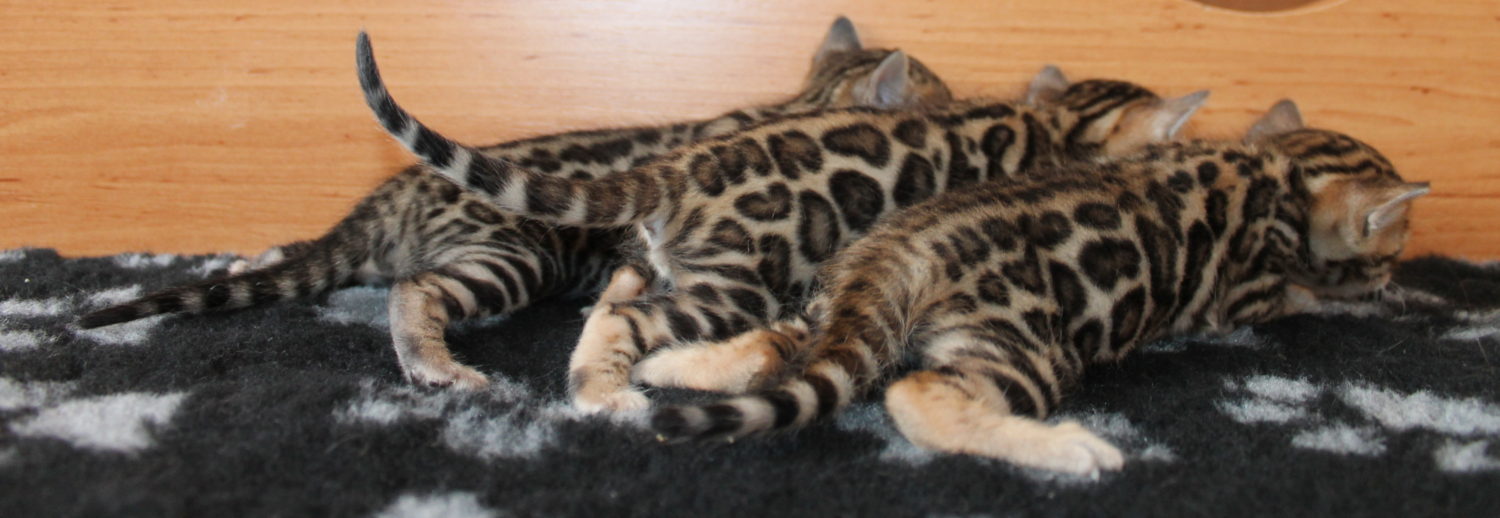HISTORY
The first mentions about crossing domestic cats with wild cats comes from the 19th century. In the first organized cat shows the breeders shown not just the Persian, Angoras, Manx, Siam and other breeds, but in every case there was a class for wild or hybrid cats. The first records we could find of a Bengal is from the year 1934 and 1941, when a Japanese cat publication printed an article about an ALC/domestic cross that was kept as a pet.
„A Jane Milwood history“ began in 1946 at UC Davis. Jean Sugden (Mill) didn´t want to cross ALC and domestic cat at first. Her original dream was to cross popular Persian breed with the Siamese breed to make „Himalayan, Panda Bear breed“. But twenty years lated she had to move on, because the board in ACFA (American Cat Fanciers Association) didn´t liked the idea of mixing them together.
Throughout the 60’s there were many well known breeders that produced Bengal’s but few took it past the F1 stage and records indicate that none were known to go past F2. In addition to breeders efforts, the Zoological Society of London mentions several ALC hybrids being born in zoo’s in Europe.
The 60’s was also a time that saw an epidemic of feline leukemia. It seemed that many wild cats had a natural immunity to the disease and some other illnesses such as FIV (Feline Immunodeficiency Virus). This would come to have a great influence on the development of the Bengal when in the 70’s Loyola University would start a research program to investigate if this natural immunity could be bred in or replicated. ( It can’t. )
The bengal breeders should thank Jane´s ALC Malaysia from SE Asia which gave a birth to the female KinKin. The father was black domestic shorthaired tomcat. She was different from infancy. She slept apart, played differently, looked and sounded foreign. She insisted on eating alone, slept in high places. She was bred to her father later and she produced a solid black daughter and a spotted son. Jean was dreaming about putting him with domestic queens and making hundreds of little leopards, but before she could learn that F2 males are sterile, he was killed by a fall from a shelf. His black sister produced a kitten, but ate it at 2 days of age. The early project ends with Jeans moving to California and tragic death of KinKin.
Later in 80´s she restarted her project with F1 kittens donated by Loma Linda University, used for the Feline Leukemia studies. Once F1´s donated their blood samples, Dr. Centerwall needed homes for them.
Jean did not want to use existing domestic breeds to create her new bred. The ALC is a genetically superiour animal compared to the existing registered breeds and her goal was to maintain as much of that superiority as possible so the search was on. Around 1982 the Mill’s made a trip to India where a zoo curator showed them a feral domestic cat that apparently lived in the rhinoceros display. Jean made arrangements to have this Indian Mau shipped to the states this was how the famous rosetted domestic called “Millwood Tory of Delhi” came to be found in virtually all Bengal pedigrees . He was the perfect answer for Jane´s needs for the F1 queens, with his small, dark-brown, distinct, all-over spots on a thick, shiny golden-orange coat.
Jean now had everything she needed to lay the foundation for a new breed and for the first time someone started breeding ALC based hybrids with full intentions of taking them well past the F2/F3 stage.
T.I.C.A. adopted the first written breed standard in 1986 and the first Bengal Bulletin was published in Nov/Dec 1988.
ABOUT BENGALS
The Bengal is most noted for it luxurious short, soft coat which may appear in either the spotted or marble pattern. Some Bengal’s coats feature something called glitter which imparts an iridescent sheen to each hair. The spotted pattern is most associated with the “leopard look” as the coat features clearly discernible spots and rosettes. The Bengal’s spots can be large or small and often include rosettes, like the spots of Jaguars and Leopards, which are two- toned spots. Bengals may also be marbled, which is a derivative of the classic or “bull’s eye” pattern found in many breeds of cats but with an especially dramatic appearance in Bengals. The marbled Bengal has a swirling pattern that appears as random swirls or thick diagonal and horizontal lines flowing across the coat of the cat.
The most popular color of the Bengal is the brown/black tabby, a lackluster description for coats that can be anywhere from a cool grey to vibrant shades of golden, bronze, copper or mahogany with spots or marbling ranging from rich browns to intense black. Bengals also come in a range of colors associated with a form of albinism, called “snow” by breeders, that indicates Siamese and Burmese ancestry. In these colors the coat appears ivory, cream or light tan with spots or marbling that may range from light brown to dark chocolate and the eye color is blue to aqua. Silver Bengals have grey to nearly white backgrounds with dark grey to black patterns. Also distinctive about the Bengal’s coloring is that they may have nearly white undersides and facial markings that still show the tabby pattern.
Bengals are medium to large cats, from 6-15 pounds, with males generally being larger than females. A healthy Bengal is well muscled and has an appearance that depicts its athleticism. Bengals are balanced cats and none of its physical features should appear exaggerated or especially pronounced.
Bengals are generally confident, curious and devoted companions. They get along well with other pets when properly introduced and enjoy being part of a family. Each Bengal is an individual and those interested should find out as much as they can about this wonderful breed before adding one to their family.
